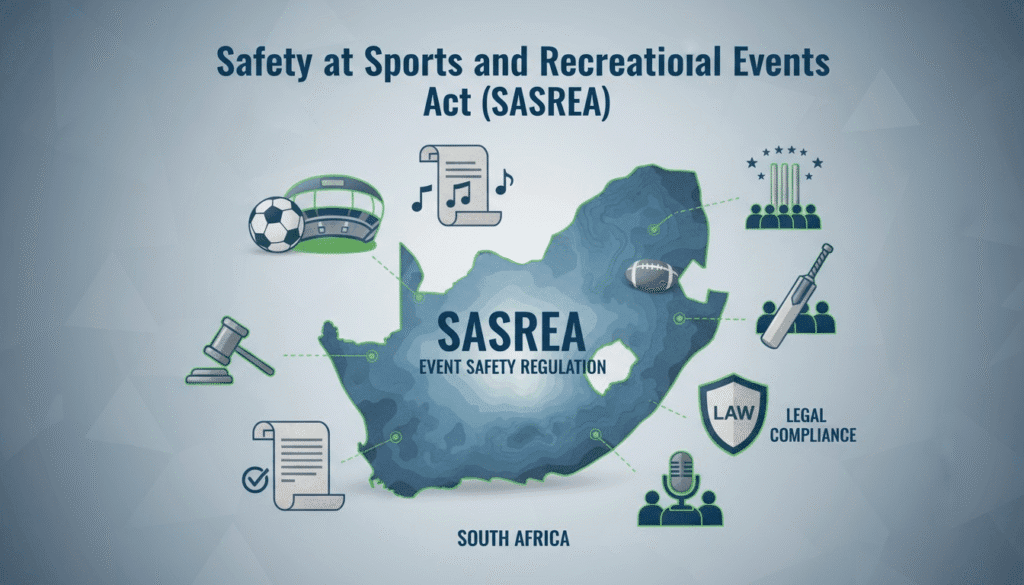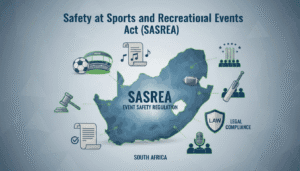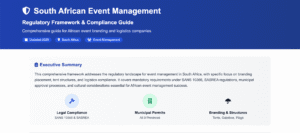When I first started working with event organizers in South Africa back in 2015, I was shocked to discover how many didn’t fully understand their legal obligations under SASREA. One promoter told me, “It’s just a music festival—surely we don’t need all that paperwork?” Fast forward six months, and that same promoter faced potential criminal charges and event cancellation. If you’re planning any sports or recreational event in South Africa, understanding the Safety at Sports and Recreational Events Act isn’t just about compliance—it’s about protecting lives and your business reputation.
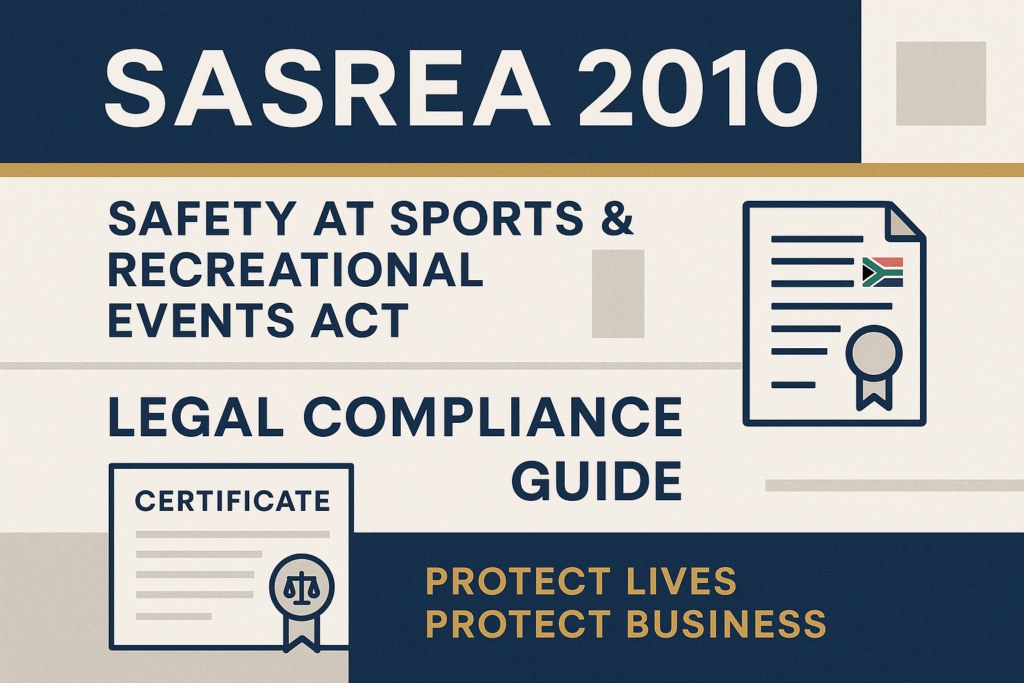
What Is the Safety at Sports and Recreational Events Act?
The Safety at Sports and Recreational Events Act, 2010 (Act 2 of 2010), commonly known as SASREA, is South Africa’s cornerstone legislation for event safety management. Passed by Parliament and enacted to replace outdated safety protocols, this Act applies to virtually all sports and recreational events regardless of size or attendance numbers.
Here’s what makes SASREA different: it doesn’t just suggest safety measures. It legally mandates them. Whether you’re organizing a township soccer match for 50 people or a stadium concert for 50,000, SASREA governs your responsibilities as an event organizer.
The Act emerged from tragic lessons learned at events where inadequate safety measures resulted in injuries and fatalities. It represents South Africa’s commitment to ensuring every person attending a sporting or recreational event returns home safely.
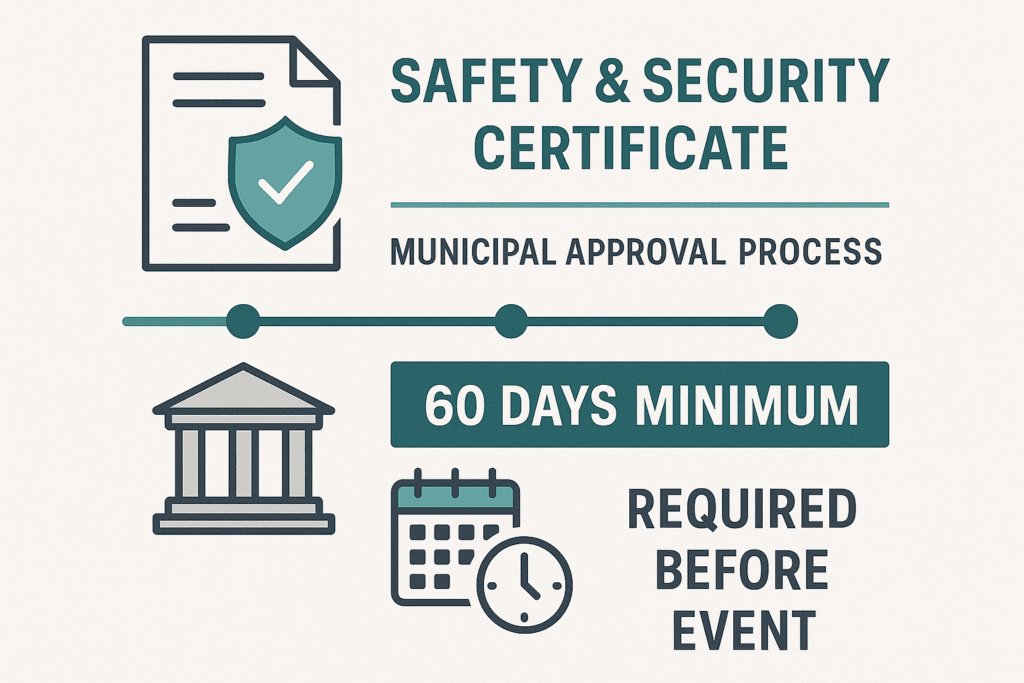
Who Must Comply with SASREA?
You might think, “Does this really apply to my event?” The answer is almost certainly yes.
Events Covered Under the Act
SASREA applies to:
- Sports events (professional and amateur): soccer matches, rugby games, cricket tournaments, athletics meets, marathons, cycling races
- Recreational events: music festivals, concerts, community fairs, cultural celebrations, outdoor gathons
- Mixed events: sporting events with entertainment components, charity runs with post-race festivals
The critical factor isn’t the event type—it’s whether members of the public will attend. If you’re charging admission or opening your event to the community, SASREA applies.
Event Organizers’ Responsibilities
Under the Act, an “event organizer” includes anyone who:
- Plans and coordinates the event
- Controls venue access and operations
- Makes safety-related decisions
- Benefits financially from the event
This broad definition means promoters, venue owners, sports clubs, municipalities, and even corporate sponsors can all share legal responsibility. I’ve seen cases where multiple parties were held accountable because they didn’t clarify who held primary organizing responsibility.
Core Requirements of SASREA
Let’s break down what the Act actually requires you to do.
Safety and Security Certification
Before any event with anticipated attendance over specified thresholds, you must obtain a Safety and Security Certificate from your local municipality. This isn’t a rubber-stamp process. The municipality will scrutinize your safety plans, and they have the authority to reject applications or impose additional conditions.
The certificate application must include:
- Detailed safety plan addressing crowd management, emergency procedures, medical services
- Security arrangements including number of security personnel, access control measures
- Traffic management plan for vehicular and pedestrian movement
- Emergency evacuation procedures with clearly marked routes and assembly points
- Fire safety measures including firefighting equipment and access for emergency vehicles
Without this certificate, your event cannot legally proceed. Period.
Risk Assessment and Safety Plans
SASREA mandates comprehensive risk assessments for all events. This means identifying potential hazards—from structural failures to crowd surges to weather emergencies—and documenting how you’ll mitigate each risk.
Your safety plan should address:
- Crowd density calculations: How many people can safely occupy each area?
- Barrier and fencing requirements: What physical controls prevent overcrowding?
- Communication systems: How will security teams and medical staff coordinate?
- Medical response capabilities: What level of medical care will be available on-site?
I’ve reviewed hundreds of these plans, and the ones that pass inspection share one quality: they’re specific. Generic boilerplate won’t cut it. Your plan must reflect the unique characteristics of your venue and event.
Venue Safety Standards
The venue itself must meet stringent safety standards:
- Structural integrity: Grandstands, stages, and temporary structures must be certified by qualified engineers
- Capacity limits: Maximum occupancy must be calculated and clearly posted
- Emergency exits: Sufficient exits that open outward, remain unlocked during events
- Lighting: Adequate emergency lighting on all exit routes
- Signage: Clear directional signs to exits, medical facilities, and assembly points
Temporary structures deserve special attention. That stage or VIP viewing platform might look sturdy, but SASREA requires professional engineering certification. Don’t rely on the supplier’s assurances alone.
Appointment of Safety Officers
For larger events, you must appoint qualified Safety and Security Officers who hold specific responsibilities during the event. These individuals need appropriate training and must have authority to make real-time safety decisions—including stopping the event if necessary.
The safety officer’s duties include:
- Pre-event safety inspections
- Monitoring crowd behavior and density
- Coordinating with emergency services
- Implementing emergency procedures when required
- Maintaining incident logs
Penalties for Non-Compliance
SASREA has teeth. Non-compliance isn’t just administratively inconvenient—it can result in serious legal consequences.
Criminal Penalties
Event organizers who violate SASREA can face:
- Criminal prosecution resulting in fines up to R100,000
- Imprisonment for up to 10 years in cases of gross negligence or willful disregard
- Personal liability for injuries or deaths resulting from safety failures
Here’s the reality: if someone gets hurt at your event because you didn’t comply with SASREA requirements, prosecutors will examine whether you obtained the proper certificates and implemented required safety measures. Your non-compliance becomes evidence of negligence.
Civil Liability
Beyond criminal penalties, you face civil lawsuits from injured parties. South African courts have consistently ruled that SASREA violations constitute negligence per se—meaning your legal duty was clear, and your failure to comply establishes liability.
I’ve witnessed event organizers lose everything—businesses, homes, savings—because they skipped “unnecessary” safety requirements to save costs.
Event Cancellation and Prohibition
Municipalities and the South African Police Service (SAPS) have authority to:
- Refuse safety certificates, preventing your event from proceeding
- Cancel events mid-way if safety concerns arise
- Prohibit future events by organizers with poor compliance records
Imagine selling 5,000 tickets, booking artists, arranging logistics—then having your event shut down because you didn’t properly submit your safety plan. It happens more often than you’d think.
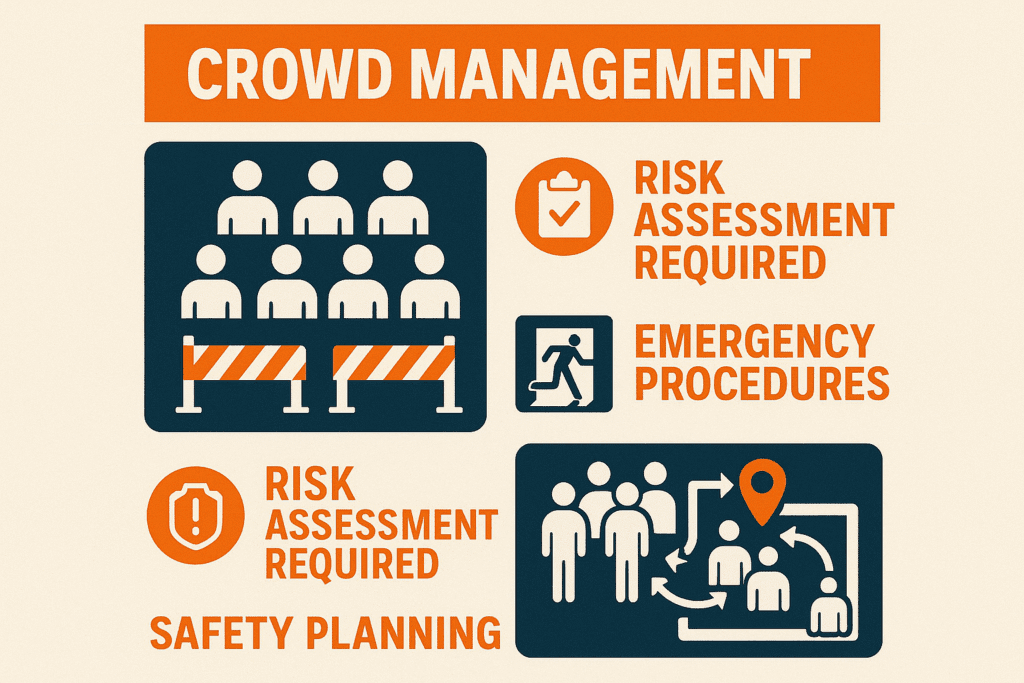
How to Ensure SASREA Compliance
Compliance might seem daunting, but breaking it into manageable steps makes the process straightforward.
Step 1: Early Planning and Timeline
Start your SASREA compliance process at least 90 days before your event. Why so early? Because:
- Municipal review processes take 30-60 days
- You may need to revise and resubmit plans
- Structural certifications require scheduling professional inspections
- Emergency services need advance notice to allocate resources
The organizers who struggle most are those who treat SASREA as an afterthought. Make safety planning central to your event design from day one.
Step 2: Engage Qualified Professionals
Don’t go it alone. Hire or consult with:
- Event safety consultants familiar with SASREA requirements
- Structural engineers to certify temporary structures
- Security companies with event-specific training and experience
- Medical service providers appropriate to your event’s risk profile
Yes, professionals cost money. But they’re far cheaper than the alternatives: event cancellation, legal liability, or tragedy.
Step 3: Build Relationships with Local Authorities
Your local municipality isn’t your adversary—they’re your partner in creating safe events. Schedule pre-application meetings where officials can:
- Review your preliminary plans
- Identify potential issues early
- Clarify specific local requirements
- Recommend improvements before formal submission
I’ve seen this single step reduce application rejections by over 60%. Municipal officials appreciate organizers who seek guidance rather than treating the certification as a bureaucratic hurdle.
Step 4: Document Everything
Create a comprehensive paper trail:
- Keep copies of all correspondence with authorities
- Document safety briefings with staff and contractors
- Maintain incident logs during events
- Record safety inspections and corrective actions
This documentation protects you legally and demonstrates your commitment to compliance. In legal proceedings, thorough documentation often makes the difference between conviction and acquittal.
Step 5: Conduct Pre-Event Testing
Before gates open:
- Walk-through inspections: Physically check all safety elements
- Communication tests: Ensure radios and emergency systems function
- Evacuation drills: Practice emergency procedures with staff
- Final briefings: Confirm everyone understands their safety responsibilities
Never assume everything will work as planned. Test, verify, and confirm.
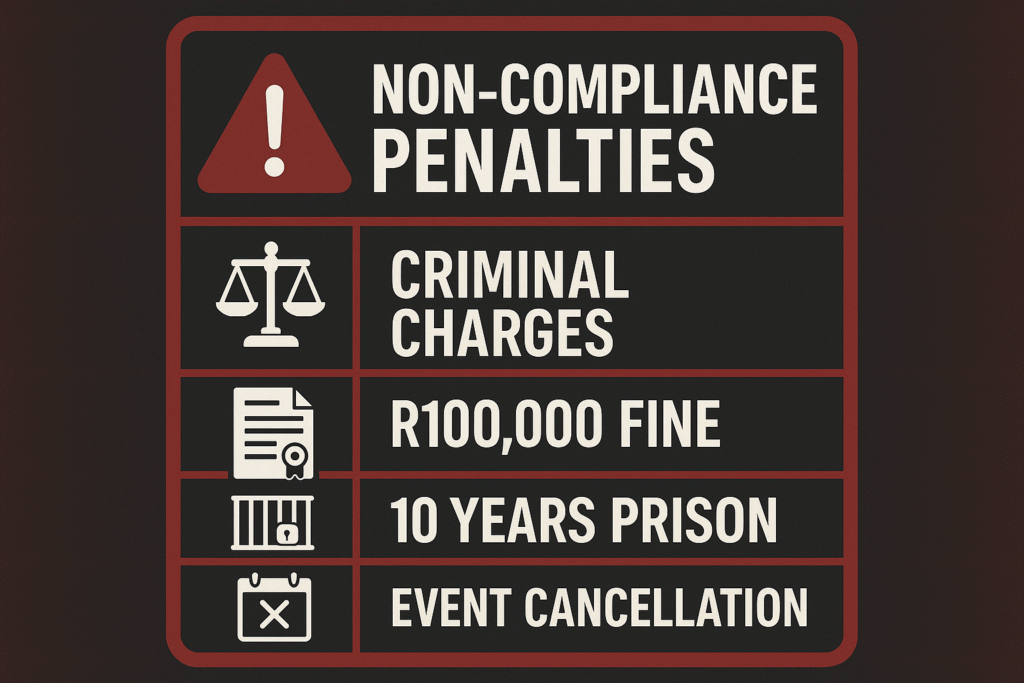
Common SASREA Compliance Mistakes
Let me share the mistakes I see repeatedly—so you can avoid them.
Underestimating Attendance
Event organizers consistently underestimate expected attendance to avoid triggering higher safety thresholds. This backfires catastrophically when actual attendance exceeds your certified capacity. Gates must close once capacity is reached, leaving ticket-holders outside and creating crowd control nightmares.
Be realistic—even conservative—in your attendance projections. It’s better to plan for 10,000 and host 8,000 than plan for 5,000 and face 10,000.
Inadequate Medical Provisions
“We’ll just have a first-aid kit” doesn’t cut it. SASREA requires medical services proportionate to:
- Event size and duration
- Crowd demographics (children, elderly attendees need different considerations)
- Nature of activities (contact sports require more extensive medical support than concerts)
- Distance from hospital facilities
For medium to large events, you’ll need paramedics with ambulance services on standby. Budget accordingly.
Ignoring Weather Contingencies
South African weather can change dramatically. Your safety plan must address:
- Severe weather procedures: When and how you’ll evacuate for lightning, high winds, or extreme heat
- Shelter provisions: Where attendees will go during weather events
- Communication protocols: How you’ll alert attendees to weather dangers
I remember a festival where organizers ignored weather forecasts because “it probably won’t rain.” When storms arrived, their inadequate shelter and emergency procedures created a dangerous situation. The municipality banned them from organizing future events.
Poor Crowd Management Planning
Crowd disasters don’t happen because too many people attend—they happen when crowd movement isn’t properly managed. Your plan must address:
- Entry and exit flow: Preventing bottlenecks at access points
- Viewing area density: Ensuring no area becomes dangerously overcrowded
- Barrier placement: Controlling movement without creating crush points
- Staff positioning: Security and stewards where crowd management is critical
Study crowd management failures worldwide. The patterns are consistent: inadequate planning leads to predictable disasters.
SASREA and COVID-19 Considerations
The pandemic added another layer to event safety in South Africa, though many restrictions have eased.
Current Requirements
As of 2024, event organizers should:
- Monitor current Department of Health regulations (which can change)
- Implement recommended health screening where appropriate
- Maintain adequate sanitation facilities
- Consider ventilation in enclosed venues
While mandatory COVID-19 restrictions have largely been lifted, showing that you’ve considered health risks in your safety planning demonstrates comprehensive risk management.
Ongoing Best Practices
Even post-pandemic, attendees appreciate:
- Available hand sanitizing stations
- Enhanced cleaning protocols for high-touch surfaces
- Options for contactless entry and transactions
- Clear communication about health and safety measures
These provisions can differentiate your event and increase attendee confidence.
Working with Municipal Authorities
Your relationship with local government officials significantly impacts your SASREA compliance experience.
Understanding Municipal Processes
Each municipality has its own procedures for:
- Application submission (online portals, physical offices, required formats)
- Review timelines (statutory periods plus practical processing times)
- Fee structures (application fees, inspection fees, late submission penalties)
- Appeals processes (if your application is rejected)
Contact your municipal events office before starting your application. Ask for:
- Application checklists and templates
- Contact information for the reviewing officials
- Timelines and deadline schedules
- Common reasons applications are rejected
Building Long-Term Relationships
If you organize events regularly:
- Attend municipal workshops on event safety
- Participate in local event organizer forums
- Provide feedback on certification processes
- Demonstrate consistent compliance
Municipalities remember reliable organizers. They’re more likely to work collaboratively with you when issues arise if you’ve built trust through consistent professionalism.
SASREA’s Role in Broader Event Legislation
SASREA doesn’t exist in isolation—it’s part of South Africa’s comprehensive event management legal framework.
Integration with Other Legislation
Your event must also comply with:
- Gatherings Act for public assemblies and demonstrations
- Liquor licensing laws if serving alcohol
- Occupational Health and Safety Act for worker protection
- National Building Regulations for temporary structures
- Municipal by-laws governing noise, trading, and public space use
SASREA establishes safety frameworks, but these other laws address specific aspects of event operations. Comprehensive compliance requires understanding how they interact.
Professional Event Management Standards
Beyond legal compliance, professional event managers follow industry best practices aligned with:
- International event safety standards (Event Safety Guide, Purple Guide)
- Insurance requirements and risk management protocols
- Professional association guidelines (SAACI, ESSA)
SASREA sets minimum legal standards. Professional excellence goes beyond mere compliance.
Resources for SASREA Compliance
Don’t navigate SASREA alone—numerous resources can help.
Government Resources
- Department of Sport, Arts and Culture: Provides SASREA guidance documents and contact information for provincial offices
- Municipal event offices: Offer local-specific guidance and application support
- SAPS Event Safety Unit: Advises on security and public safety requirements
Professional Associations
- Event Safety South Africa (ESSA): Industry body promoting event safety standards
- Southern African Association for the Conference Industry (SAACI): Professional development and best practice sharing
- Provincial event organizer networks: Peer support and information sharing
Training and Certification
Consider enrolling in:
- Event safety management courses
- Crowd management training programs
- First aid and emergency response certification
- SASREA-specific workshops offered by industry associations
Investing in professional development improves compliance and reduces risk.
Frequently Asked Questions
Do small community events need SASREA compliance?
Yes, SASREA applies regardless of event size, though requirements scale proportionally. Even a small community sports day needs basic safety planning and potentially municipal notification. However, formal Safety and Security Certificates may only be required above certain attendance thresholds—check with your local municipality.
How far in advance should I apply for a Safety Certificate?
Submit applications at least 60 days before your event, though 90 days is safer. This allows time for review, potential revisions, and appeals if necessary. Last-minute applications often get rejected simply due to insufficient review time.
Can I organize an event without a Safety Certificate?
No. Proceeding without required certification is a criminal offense under SASREA. Your event can be shut down, you’ll face penalties, and you assume enormous legal liability for any incidents.
What happens if weather forces me to cancel my event?
Your safety plan should include cancellation and postponement procedures. If you cancel for legitimate safety reasons and followed proper protocols, you’ve demonstrated responsible management. However, ticket refund obligations are typically governed by your terms and conditions and consumer protection law, not SASREA.
Who can conduct risk assessments for my event?
Risk assessments should be conducted by someone with appropriate expertise—this could be an experienced event manager, safety consultant, or specialized risk assessment professional. For high-risk events, municipalities may require assessments by certified professionals.
Does SASREA apply to private events?
If your event is truly private (invitation-only, no public access, no commercial purpose), SASREA may not apply. However, the line between private and public events is often blurry. When in doubt, consult your municipality—claiming an event is private doesn’t shield you from liability if something goes wrong.
Take Action: Ensure Your Event Compliance
Understanding SASREA is your first step toward creating safe, legally compliant events in South Africa. But knowledge without action accomplishes nothing.
If you’re planning an event:
- Start your compliance process now—don’t wait until deadlines loom
- Schedule a consultation with your municipality—understand local requirements before investing heavily in plans
- Engage qualified professionals—safety consultants and specialists protect your interests
- Document everything—comprehensive records demonstrate your commitment to compliance
- Learn from each event—continuously improve your safety management systems
The event industry in South Africa has matured significantly since SASREA’s introduction in 2010. Professionalization is no longer optional—it’s expected by authorities, attendees, and the courts.
For comprehensive event management support and SASREA compliance assistance, explore BW Productions’ event management services. Our experienced team helps South African event organizers navigate the complex legislative landscape while creating memorable, safe events.
Contact our event safety specialists for a consultation on your upcoming event, or browse our event planning resources for additional guidance on South African event legislation.
Remember: safety isn’t expensive—it’s priceless. Every attendee who enjoys your event and returns home safely validates your commitment to professional event management. That’s not just compliance—that’s excellence.

